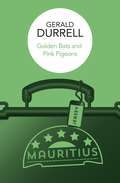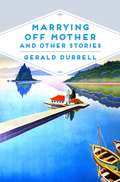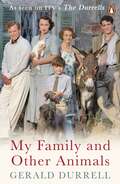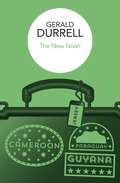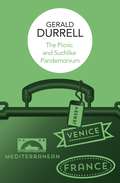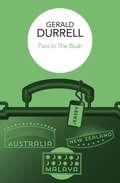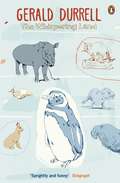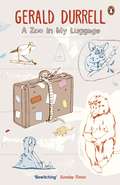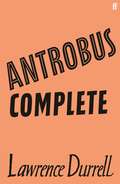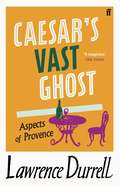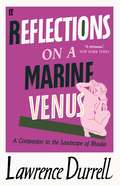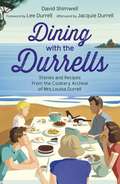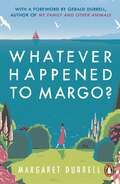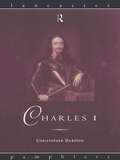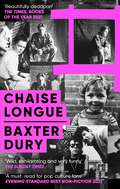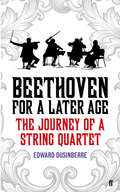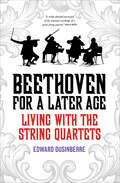- Table View
- List View
Golden Bats and Pink Pigeons: A Journey To The Flora And Fauna Of A Unique Island (El\libro De Bolsillo Ser.)
by Gerald DurrellMauritius, the green and mountainous island in the Indian Ocean, was once the home of the ill-fated dodo, and by the 1970s it still had many unique but seriously endangered species. To rescue some of these creatures from extinction, Gerald Durrell spent uncomfortable nights in the jungle looking for bats and pink pigeons, and climbed near-vertical rock faces to find Telfair's skinks and Gunther's geckos, spending his spare time exploring the enchanted worlds of the coral reefs with their varied multicoloured marine life. By the end of his trip, he had an extraordinary collection of animals to take to his Jersey sanctuary from where the progeny could, in time, be restored to Mauritius.
Marrying Off Mother and Other Stories: And Other Stories (Pan Heritage Classics #7)
by Gerald Durrell'Which of these stories is true and which is semi-true I have, of course, not the slightest intention of telling you, but I hope this will not detract from your enjoyment . . .'Gerald Durrell introduces an eccentric cast of characters in this entertaining collection of stories, first published in 1991.In the title story, part of the inspiration behind the ITV drama The Durrells, we join his family in Corfu, where Gerry joins forces with Larry and Margo in encouraging Mother to consider finding a new husband, only to rue the consequences. Highlights from the other tales in this collection are the acquisition of a strongly perfumed pig named Esmerelda, a foul-mouthed parrot called Moses, and a compulsive gambler who inspires a miracle.Written with Durrell's usual sharp eye for observing humour in a situation, Marrying Off Mother will delight fans both old and new.
Menagerie Manor: A Zoo In My Luggage, The Whispering Land, And Menagerie Manor (The\zoo Memoirs Ser. #3)
by Gerald Durrell'Most children at the tender age of six or so are generally full of the most impractical schemes for becoming policemen, firemen or engine drivers when they grow up... I knew exactly what I was going to do: I was going to have my own zoo.' This is the hugely entertaining account of how the much-loved conservationist and author Gerald Durrell fulfilled his lifelong ambition by founding his own private sanctuary for endangered species in Jersey with the help of an enduring wife, a selfless staff and a reluctant bank manager. With a foreword by Lee Durrell, Honorary Director of the Durrell Wildlife Conservation Trust, this book about the trials and wonders of living in the middle of a zoo is a classic that will continue to bring pleasure to those who grew up reading Durrell, and deserves a whole new readership.
My Family and Other Animals (The Corfu Trilogy #Vol. 3)
by Gerald DurrellMy Family and Other Animals is the first book in The Corfu Trilogy, the inspiration for ITV'sThe Durrells. The bewitching account of a rare and magical childhood on the island of Corfu by treasured British conservationist Gerald DurrellEscaping the ills of the British climate, the Durrell family - acne-ridden Margo, gun-toting Leslie, bookworm Lawrence and budding naturalist Gerry, along with their long-suffering mother and Roger the dog - take off for the island of Corfu.But the Durrells find that, reluctantly, they must share their various villas with a menagerie of local fauna - among them scorpions, geckos, toads, bats and butterflies.Recounted with immense humour and charm My Family and Other Animals is a wonderful account of a rare, magical childhood.'Durrell has an uncanny knack of discovering human as well as animal eccentricities' Sunday Telegraph'A bewitching book' Sunday Times
The New Noah
by Gerald DurrellIf you want to know how to capture, and then make friends with an ant-eater, an electric eel, or a porcupine or a boa-constrictor, this is your book. When Gerald Durrell goes wild-animal hunting he takes interest and affection along with his nets and traps. And his captives enjoy luxury treatment as he discovers how to feed and train them and prepare them for display in the zoos to which they are destined. This is a fascinating book, for the reader is let into many secrets of the animal hunter’s trade, as well as being introduced to a variety of charming and curious animals such as capybaras, hoatzins, and tucotucos, not to mention a tame curassow called Cuthbert.
The Picnic and Suchlike Pandemonium
by Gerald DurrellIf you loved My Family and Other Animals and can’t get enough of the Durrells after the Corfu series, this is the book for you. It constitutes a series of anecdotal snippets and short stories including ‘The Picnic’, a laugh-out-loud account of an ill-fated Durrell family excursion, which should have been a relaxing, jolly affair. But with the Durrells things are seldom straightforward and on this occasion all that could go wrong did go wrong - except Gerald Durrell's sense of humour in recounting the tale. Other hilarious and surreal Roald Dahlesque stories ensue, including the critically acclaimed Gothic horror story ‘The Entrance’.
The Stationary Ark (El\libro De Bolsillo Ser.)
by Gerald Durrell‘What we tried to do in Jersey is create a new sort of zoo. I think we have succeeded.’ In this important book Gerald Durrell describes his battles to create his vision of a new sort of zoo at Jersey with descriptions of his successes and failures with a liberal sprinkling of zoo animal tales on the way. Much of Gerald Durrell's long-standing basic captive breeding and conservation vision, which may, in a new century, seem almost obvious, is set out here along with prophecies - just one almost throwaway instance: ‘In our next step, we plan to form the Trust into a kind of mini-university of wildlife husbandry and breeding’.
Three Singles to Adventure
by Gerald DurrellGerald Durrell is on his way to South America on a quest to capture specimens that have never before been brought back alive. And it turns into quite an adventure when he encounters timid squirrel monkeys, wailing rats, an overly affectionate bird christened Cuthbert and a bad-tempered anaconda! Bringing back a living collection of animals can be frustrating, exciting and damned hard work, but it’s never dull!
Two in the Bush (El\libro De Bolsillo Ser.)
by Gerald DurrellTwo in the Bush is a record of the six-month journey which took Gerald Durrell, his wife Jacquie, and two cameramen through New Zealand, Australia and Malaya. The object was, first, to see what was being done about the conservation of wild life in these countries, and, secondly, to make a series of television films for the BBC. They were introduced to many rare and remarkable animals – Royal Albatrosses, Tuataras, Duck-Billed Platypuses, Flying Lizards and Long-Nosed Bandicoots, as well as to some equally unusual humans. Anyone who has read The Overloaded Ark, The Bafut Beagles or The Whispering Land will have enjoyed Gerald Durrell’s enthusiastic adventuring and his delight in the absurdity of the situations in which he finds himself. His observation of animal – and human – behaviour is always informative and often hilarious. ‘Delightfully readable and often very funny.’ Daily Mail ‘An account of Gerald Durrell’s tour of New Zealand, Australia and Malaya in search of rarities . . . Easy to read, difficult to put down, with many vivid sidelights on the human side of the expedition. This absorbing narrative reveals the ardours, ironies and disappointments, the organizational miracles and the hilarious human mishaps . . .’ Maurice Wiggin, Sunday Times ‘Mr Durrell has the knack of writing about animals and their antics with tremendous affection and enthusiasm, but without sentimentality.’ Sunday Telegraph ‘Will delight his fans and armchair naturalists everywhere.’ Evening Standard
The Whispering Land: A Zoo In My Luggage, The Whispering Land, And Menagerie Manor (The\zoo Memoirs Ser. #2)
by Gerald Durrell'When you have a large collection of animals to transport from one end of the world to the other you cannot, as a lot of people seem to think, just hoist them aboard the nearest ship and set off with a gay wave of your hand.'Gerald Durrell and his wife are the proud owners of a small zoo on the island of Jersey. But there's one thing that's better than a small zoo - a bigger one! So Durrell heads off to South America to collect more animals.Along windswept Patagonian shores and in Argentine tropical forests, he encounters a range of animals from penguins to elephant seals. But as always, he is drawn to those rare and interesting creatures which he hopes will thrive and breed in captivity . . .Told with enthusiasm and without sentimentality, Gerald Durrell's The Whispering Land is an often hilarious but always inspiring foray into the South American wilds.
A Zoo in My Luggage: A Zoo In My Luggage, The Whispering Land, And Menagerie Manor (The\zoo Memoirs Ser. #1)
by Gerald DurrellThe true and hilarious story of how Gerald Durrell and his wife set up their own zoo. Journeying to the Cameroons, he and his wife, helped by the renowned Fon of Bafut, managed to collect 'plenty beef.' Their difficulties began when they found themselves back at home, with Cholmondely the chimpanzee, Bug-Eye the bush-baby, and other founder members... and nowhere to put them
Antrobus Complete
by Lawrence DurrellThe British Foreign Office is a timeless institution. Antrobus is the embodiment of everything that makes it what it is. His tales of diplomatic misadventure, accompanied by memorable and witty drawings, make a collection to cherish, for as long as the Foreign Office holds sway over far-flung British interests.'Whatever wars there may be and whatever crises, there will still, please heaven, be the diplomatic corps, with its protocol and formalities and a field of humour which I have never seen better used than in these stories.' John Betjeman
Caesar's Vast Ghost: Aspects Of Provence
by Lawrence DurrellProvence, Southern France. Celebrated writer and poet Lawrence Durrell made the Midi his home for more than thirty years: and in this classic memoir, his final book, he shares his most evocative, dazzling memories of life as a local. A seductive blend of travelogue, poet's notebook, and intimate autobiography, Durrell guides us through the rich layers of human history that lie beneath the region's legendary landscapes. From stories of magic and mythology infusing the rolling vineyards and vivid lavender fields to tales of Roman conquest, bull-worship, and courtly love beneath the wounded blue skies, Ceasar's Vast Ghost is a book to be treasured.'A richly characteristic bouillabaisse by our last great garlicky master of the vanishing Mediterranean, our old Prospero of the south ...' Richard Holmes, Times
Reflections on a Marine Venus: A Companion to the Landscape of Rhodes (Altaïr Viajes Ser.)
by Lawrence DurrellWorld War II is finally over, and after four tortuous years serving the Crown in Egypt, Lawerence Durrell seeks peace in the landscapes he has loved since growing up in Corfu: ancient Mediterranean islands. He is posted to Rhodes, and from his first dip in the dazzling blue Aegean - which jolts his soul awake for the first time in years - he immerses himself in the rhythms and moods of local life, befriending eccentric villagers and quaffing ouzo as through the war was a distant dream. With his poet's eye and passion for excavating local history, Durrell recaptures the mythic Rhodes of legend, of knights and crusades, that lies beneath its war-ravaged surface. Rich in character, wit, and insight, it is a Mediterranean journey that will stay with you forever.'Remarkable.' New York Times'He excites a longing to leave for Rhodes at once.' Sunday Times
Dining with the Durrells: Stories and Recipes from the Cookery Archive of Mrs Louisa Durrell
by Lee Durrell David Shimwell'We lolled in the sea until it was time to return for tea, another of Mother's gastronomic triumphs. Tottering mounds of hot scones; crisp paper-thin biscuits; cakes like snowdrifts, oozing jam; cakes dark, rich and moist, crammed with fruit; brandy snaps brittle as coral and overflowing with honey. Conversation was almost at a standstill; all that could be heard was the gentle tinkle of cups, and the heartfelt sigh of some guest, accepting another slice of cake.' - My Family and Other Animals, Gerald DurrellIn Dining with the Durrells, David Shimwell has delved into the Durrell family archives to uncover Louisa Durrell's original recipes for the scones, cakes, jams, tarts, sandwiches and more that are so deliciously described by the Durrell family. From her recipe for 'Gerry's Favourite Chicken Curry' to 'Dixie-Durrell Scones with Fig and Ginger Jam', and including the family stories and photos that accompany them, this book will transport you to long lunches enjoyed on the terrace of a strawberry-pink villa, sunshine-filled picnics among the Corfu olive groves and candlelit dinners overlooking the Ionian Sea.
Whatever Happened to Margo? (Isis Large Print Ser.)
by Margaret DurrellIn 1947, returning to the UK with two young children to support, Margaret Durrell starts a boarding house in Bournemouth. But any hopes of respectability are dashed as the tenants reveal themselves to be a host of eccentrics: from a painter of nudes to a pair of glamorous young nurses whose late-night shifts combined with an ever-revolving roster of gentleman callers leading to a neighbourhood rumour that Margo is running a brothel. Margo's own two sons, Gerry and Nicholas, prove to be every bit as mischievous as their famous Uncle Gerald - and he himself returns periodically with weird and wonderful animals, from marmosets to monkeys, that are quite unsuitable for life in a Bournemouth garden.
Charles I (PDF)
by Christopher DurstonThis book considers the personality of Charles and the effect of his decisions as ruler. Beginning with Charles as a prince, Durston goes on to assess the monarch's role in the outbreak of war and the crisis of the 1640s. Centring on the degree of personal responsibility Charles should bear for the events of his reign, the author considers: * contemporary and modern portrayals of Charles' reign * the King's military leadership * the context and prelude to his execution * his status as a martyr king in the 1650s and beyond.
Charles I
by Christopher Durston Charles CarltonThis book considers the personality of Charles and the effect of his decisions as ruler. Beginning with Charles as a prince, Durston goes on to assess the monarch's role in the outbreak of war and the crisis of the 1640s. Centring on the degree of personal responsibility Charles should bear for the events of his reign, the author considers: * contemporary and modern portrayals of Charles' reign * the King's military leadership * the context and prelude to his execution * his status as a martyr king in the 1650s and beyond.
Chaise Longue
by Baxter DuryMethods of parenting and education have progressed in recent years, especially compared to some of the more casually experimental routes inflicted on children of artistic professionals in the 70s and 80s. One experience that would take some beating is that endured by Baxter Dury.When punk rock star Ian Dury disappeared to make films in the late 80s, he left his teenage son in the care of his roadie, in a rundown flat in Hammersmith. But this was no ordinary roadie; this was the Sulphate Strangler. The Strangler, having taken a lot of LSD in the 60s, was prone to depression, anger and hallucinations. He was also, as the name suggests, a drug dealer. What could possibly go wrong?In a period that we can now only imagine, a young Baxter ricocheted from one adventure to another, narrowly swerving one disaster only immediately to collide with another. At times, his situation was perilous in the extreme - the world is lucky to have him at all. CHAISE LONGUE is an intimate account of those escapades, evocatively illuminating a bohemian west London populated with feverishly grubby characters. Narrated in Dury's candid tone, both sad and funny, this moving story will leave an indelible imprint on its readers.
Beethoven for a Later Age: The Journey of a String Quartet
by Edward Dusinberre'They are not for you but for a later age!' Ludwig van Beethoven, on the Opus 59 quartets.Tackling the Beethoven quartets is a rite of passage that has shaped the Takács Quartet's work together for over forty years. Using the history of the composition and first performances of the quartets as the backbone to his story, Edward Dusinberre, first violinist of the Takács since 1993 - recounts the life of the Quartet from its inception in Hungary, through emigration to the US and its present-day life as one of the world's renowned string quartets. He also describes what it was like for him, as a young man fresh out of the Juilliard School, to join the Quartet as its first non-Hungarian member - an exhilarating challenge. Beethoven for a Later Age takes the reader inside the life of a quartet, vividly showing how four people enjoy making music together over a long period of time. The key, the author argues, is in balancing continuity with change and experimentation - a theme that also lies at the heart of Beethoven's remarkable compositions.
Beethoven for a Later Age: Living with the String Quartets
by Edward DusinberreBeethoven’s sixteen string quartets are some of the most extraordinary and challenging pieces of music ever written. Originally composed and performed between 1798 and 1826, they have inspired artists of all kinds—not only musicians—and have been subject to endless reinterpretation. But what is it like to personally take up the challenge of these compositions, not only as a musician, but as a member of a quartet, where each player has ideas about style and expression? To answer this question, Edward Dusinberre, first violinist of the renowned Takács Quartet, offers a rare peek inside the workings of his ensemble, while providing an insightful history of the compositions and their performance. Founded in Hungary in 1975 and now based in Boulder, Colorado, the Takács is one of the world’s preeminent string quartets, and performances of Beethoven have been at the center of their work together for over forty years. Using the history of both the Takács Quartet and the Beethoven quartets as a foundation, Beethoven for a Later Age provides a backstage look at the daily life of a quartet, showing the necessary creative tension between individual and group and how four people can at the same time forge a lasting artistic connection and enjoy making music together over decades. The key, Dusinberre reveals, to a quartet crafting its own sound is in balancing continuity with change and experimentation—a theme that lies at the heart of Beethoven’s remarkable compositions. In an accessible style, suitable for novices and chamber music enthusiasts alike, Dusinberre illuminates the variety and contradictions of Beethoven's quartets, which were composed against the turbulent backdrop of the Napoleonic Wars and their aftermath, and he brings the technical aspects of the music to life. Beethoven for a Later Age vividly shows that creative engagement with Beethoven’s radical and brilliant quartets continues to be as stimulating now as it was for its first performers and audiences. Musicians and music lovers will be intrigued by Dusinberre’s exploration of the close collaboration at the heart of any great performance.
Beethoven for a Later Age: Living with the String Quartets
by Edward DusinberreBeethoven’s sixteen string quartets are some of the most extraordinary and challenging pieces of music ever written. Originally composed and performed between 1798 and 1826, they have inspired artists of all kinds—not only musicians—and have been subject to endless reinterpretation. But what is it like to personally take up the challenge of these compositions, not only as a musician, but as a member of a quartet, where each player has ideas about style and expression? To answer this question, Edward Dusinberre, first violinist of the renowned Takács Quartet, offers a rare peek inside the workings of his ensemble, while providing an insightful history of the compositions and their performance. Founded in Hungary in 1975 and now based in Boulder, Colorado, the Takács is one of the world’s preeminent string quartets, and performances of Beethoven have been at the center of their work together for over forty years. Using the history of both the Takács Quartet and the Beethoven quartets as a foundation, Beethoven for a Later Age provides a backstage look at the daily life of a quartet, showing the necessary creative tension between individual and group and how four people can at the same time forge a lasting artistic connection and enjoy making music together over decades. The key, Dusinberre reveals, to a quartet crafting its own sound is in balancing continuity with change and experimentation—a theme that lies at the heart of Beethoven’s remarkable compositions. In an accessible style, suitable for novices and chamber music enthusiasts alike, Dusinberre illuminates the variety and contradictions of Beethoven's quartets, which were composed against the turbulent backdrop of the Napoleonic Wars and their aftermath, and he brings the technical aspects of the music to life. Beethoven for a Later Age vividly shows that creative engagement with Beethoven’s radical and brilliant quartets continues to be as stimulating now as it was for its first performers and audiences. Musicians and music lovers will be intrigued by Dusinberre’s exploration of the close collaboration at the heart of any great performance.
Beethoven for a Later Age: Living with the String Quartets
by Edward DusinberreBeethoven’s sixteen string quartets are some of the most extraordinary and challenging pieces of music ever written. Originally composed and performed between 1798 and 1826, they have inspired artists of all kinds—not only musicians—and have been subject to endless reinterpretation. But what is it like to personally take up the challenge of these compositions, not only as a musician, but as a member of a quartet, where each player has ideas about style and expression? To answer this question, Edward Dusinberre, first violinist of the renowned Takács Quartet, offers a rare peek inside the workings of his ensemble, while providing an insightful history of the compositions and their performance. Founded in Hungary in 1975 and now based in Boulder, Colorado, the Takács is one of the world’s preeminent string quartets, and performances of Beethoven have been at the center of their work together for over forty years. Using the history of both the Takács Quartet and the Beethoven quartets as a foundation, Beethoven for a Later Age provides a backstage look at the daily life of a quartet, showing the necessary creative tension between individual and group and how four people can at the same time forge a lasting artistic connection and enjoy making music together over decades. The key, Dusinberre reveals, to a quartet crafting its own sound is in balancing continuity with change and experimentation—a theme that lies at the heart of Beethoven’s remarkable compositions. In an accessible style, suitable for novices and chamber music enthusiasts alike, Dusinberre illuminates the variety and contradictions of Beethoven's quartets, which were composed against the turbulent backdrop of the Napoleonic Wars and their aftermath, and he brings the technical aspects of the music to life. Beethoven for a Later Age vividly shows that creative engagement with Beethoven’s radical and brilliant quartets continues to be as stimulating now as it was for its first performers and audiences. Musicians and music lovers will be intrigued by Dusinberre’s exploration of the close collaboration at the heart of any great performance.
Beethoven for a Later Age: Living with the String Quartets
by Edward DusinberreBeethoven’s sixteen string quartets are some of the most extraordinary and challenging pieces of music ever written. Originally composed and performed between 1798 and 1826, they have inspired artists of all kinds—not only musicians—and have been subject to endless reinterpretation. But what is it like to personally take up the challenge of these compositions, not only as a musician, but as a member of a quartet, where each player has ideas about style and expression? To answer this question, Edward Dusinberre, first violinist of the renowned Takács Quartet, offers a rare peek inside the workings of his ensemble, while providing an insightful history of the compositions and their performance. Founded in Hungary in 1975 and now based in Boulder, Colorado, the Takács is one of the world’s preeminent string quartets, and performances of Beethoven have been at the center of their work together for over forty years. Using the history of both the Takács Quartet and the Beethoven quartets as a foundation, Beethoven for a Later Age provides a backstage look at the daily life of a quartet, showing the necessary creative tension between individual and group and how four people can at the same time forge a lasting artistic connection and enjoy making music together over decades. The key, Dusinberre reveals, to a quartet crafting its own sound is in balancing continuity with change and experimentation—a theme that lies at the heart of Beethoven’s remarkable compositions. In an accessible style, suitable for novices and chamber music enthusiasts alike, Dusinberre illuminates the variety and contradictions of Beethoven's quartets, which were composed against the turbulent backdrop of the Napoleonic Wars and their aftermath, and he brings the technical aspects of the music to life. Beethoven for a Later Age vividly shows that creative engagement with Beethoven’s radical and brilliant quartets continues to be as stimulating now as it was for its first performers and audiences. Musicians and music lovers will be intrigued by Dusinberre’s exploration of the close collaboration at the heart of any great performance.
Beethoven for a Later Age: Living with the String Quartets
by Edward DusinberreBeethoven’s sixteen string quartets are some of the most extraordinary and challenging pieces of music ever written. Originally composed and performed between 1798 and 1826, they have inspired artists of all kinds—not only musicians—and have been subject to endless reinterpretation. But what is it like to personally take up the challenge of these compositions, not only as a musician, but as a member of a quartet, where each player has ideas about style and expression? To answer this question, Edward Dusinberre, first violinist of the renowned Takács Quartet, offers a rare peek inside the workings of his ensemble, while providing an insightful history of the compositions and their performance. Founded in Hungary in 1975 and now based in Boulder, Colorado, the Takács is one of the world’s preeminent string quartets, and performances of Beethoven have been at the center of their work together for over forty years. Using the history of both the Takács Quartet and the Beethoven quartets as a foundation, Beethoven for a Later Age provides a backstage look at the daily life of a quartet, showing the necessary creative tension between individual and group and how four people can at the same time forge a lasting artistic connection and enjoy making music together over decades. The key, Dusinberre reveals, to a quartet crafting its own sound is in balancing continuity with change and experimentation—a theme that lies at the heart of Beethoven’s remarkable compositions. In an accessible style, suitable for novices and chamber music enthusiasts alike, Dusinberre illuminates the variety and contradictions of Beethoven's quartets, which were composed against the turbulent backdrop of the Napoleonic Wars and their aftermath, and he brings the technical aspects of the music to life. Beethoven for a Later Age vividly shows that creative engagement with Beethoven’s radical and brilliant quartets continues to be as stimulating now as it was for its first performers and audiences. Musicians and music lovers will be intrigued by Dusinberre’s exploration of the close collaboration at the heart of any great performance.
